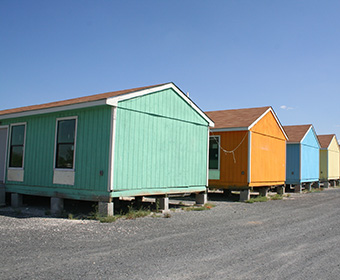New UTSA exhibit looks at the consequences of the latest Texas oil boom

Exhibit on the Eagle Ford Shale's effect on housing runs May 13 to Oct. 1 at the UTSA Institute of Texan Cultures.
(May 5, 2017) -- The oil boom in the Eagle Ford Shale region of Dimmit, La Salle, and Zavala counties permanently transformed the face of South Texas. For five years, the petroleum industry generated fantastic economic opportunities, creating employment and wealth. Nonetheless, there were consequences to the scale of economic impact that the oil boom had on the region.
In a new exhibit at the UTSA Institute of Texan Cultures, May 13 to Oct. 1, researchers from the UTSA Mexico Center and UTSA Institute for Economic Development showcase the results of an ethnographic study on the Eagle Ford Shale's effect on housing.
With the demand for workers in the oil fields, Zavala, Dimmit and LaSalle counties saw a surge in housing construction, along with amenities for the area, including increased commerce, fast food, short-term lodging, and other products and services.
The virtual overnight surge of workers arriving in the region created a shortage in the housing supply. The three counties, which relied previously on rural agrarian economic generators, saw an influx of demand and an influx of money, driving up the cost of housing and pushing the American Dream of home ownership out of range for many local residents.
"These counties already lacked accessible, quality, affordable housing," said Harriett Romo, UTSA professor of sociology and director of the Mexico Center. "Rents increased exponentially. When families pay more than 35 percent of available income for housing, they are unable to afford medical care, educational expenses, savings for retirement, or investments in the younger generation and their community."
Over their two years of studying the region, the research team accumulated hundreds of photographs and hours of interviews for the exhibit, which was funded by the cooperative agreement RP-14-TX-004 under the Research Partnerships program from the U.S. Department of Housing and Urban Development.
The exhibit sections follow three key factors the researchers set out to record: the impact of oil and gas exploration on low-cost housing stock, how stakeholders responded to housing availability and affordability in the region, and the strategies local officials used to address affordable housing and infrastructure needs in the region.
"Housing is a basic necessity," said Romo. "Affordable, high quality housing is an essential part of a viable community. With this exhibit we are urging local and state leaders to use the economic opportunities created by the Eagle Ford Shale oil and gas reserves to invest in their communities. We hope this exhibit makes people aware of the challenges and the potential in South Texas as a result of the resources in the Eagle Ford Shale area."
The Institute of Texan Cultures is located on the UTSA Hemisfair Campus, 801 E. César E. Chávez Blvd. Regular hours are 9 a.m. to 5 p.m. Monday through Saturday and 12 p.m. to 5 p.m. Sunday.
-------------------------------
For more information, call 210-458-2300 or visit Texancultures.com.
Connect with UTSA online at Facebook, Twitter, YouTube, Instagram and LinkedIn.
Events
Huddle Against Hunger is a fundraising competition with Texas State that benefits our Roadrunner Pantry. Donations this week will help UTSA earn additional prize monies provided by RBFCU.
In-Person and VirtualJoin UTSA Libraries for an update on federal public access policies and how the library can assist with compliance.
Virtual EventWe invite you to join us for Birds Up! Downtown, an exciting welcome back event designed to connect students with the different departments at the Downtown Campus. Students will have the opportunity to learn about some of the departments on campus, gain access to different resources, and collect some giveaways!
Bill Miller PlazaThere are many citation managers. Which one is right for you? This workshop will explain what a citation manager is and how it can help you organize your citations, insert citations as you write your paper, and generate your bibliography.
Virtual EventPubMed is an essential database for anyone conducting biomedical or health-related research. This workshop will teach attendees how to effectively navigate this free resource and locate peer-reviewed articles using advanced search features, MeSH subject headings, and Boolean operators.
Virtual EventIn this hands-on workshop, participants will learn to setup an EndNote library, save references and PDFs, and automatically create and edit a bibliography. Attendees are encouraged, but not required, to have EndNote already installed on a personal computer.
Virtual EventJoin UTSA Libraries and Museums to learn more about the publishing discounts available for UTSA researchers. Current agreements include Elsevier, Cambridge University Press, Wiley, and more. Bring your questions and feedback for the library as we continue to pursue partnerships with publishers to reduce costs for our researchers.
Virtual Event

